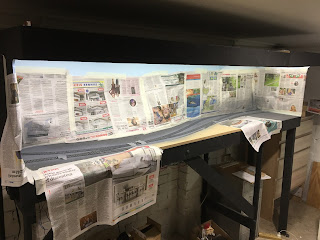On the last day of 2020 my brother came over and helped me run an operations session on Mount Wilson to both test out whether after nearly 2 years of construction it still holds my interest from the original concept, and to ensure that all of the switches, servos, uncouplers and trackwork is up to scratch.
Buildings were placed on the layout to highlight drop off points, identify sidings, and get a feel for what it's all going to look like after a few more hours' work.
Mount Wilson. Sometime in 1979...
We started the theoretical roster in the early hours of the morning (ignore the midday lighting) with a local goods from Bell brought in by 4887 to swap the fuel tanker over and the fruit co-op siding.

Being the first train this highlighted some very dirty track. My normal track cleaning routine is to go over the entire layout with a Peco track rubber and give it a good clean. I'd heard that isopropyl alcohol on some paper towel would provide a better clean, particularly for DCC, but remained unconvinced until our ops session. Below is the grot the first go with the isopropyl brought off, despite me cleaning the layout that morning. Call me Caesar and take me to the Iso temple - I'm converted.
After the quick clean, trains resumed.
The 48 continued shunting and waited on the main for the morning commuter service (a partial MUB set) to arrive.
Normally this would be a 46 class, but I'm still waiting to get that converted to DCC. The local goods departed and the 85 changed ends to head back to Bell to connect with a service to the big smoke.

Next
a local coal arrives. In my layout scenario, the mine has opened a larger loader a little further on down the branch beyond this terminus. Smaller trains still call here at Mt Wilson yard to use the old loader while operations settle. I have an operating rule on this siding that the mine company won't allow electrics under the loader. The 85 rearranges the van and proceeds to shunt wagons through the loader

A U set arrives with a mid-morning commuter service to the city. The 85 will follow it out, back to Bell.

All trains back in the fiddle yard after about 2.5 hours' operating time.

Overall, I'm quite impressed with how it all went. To be honest, the constant backwards steps and slow progress had me considering tearing the lot down and starting again, but I was really glad after we ran it all through. The spark from the original concept was still there and provided both a variety of trains and achievable operations.
Some lessons were identified:
-the local goods needs to use the coal siding to run around due to a lack of uncouplers. I'm ok with this for now.
-the imposition of 'mine company rules' for the siding (speed limit, ban on use of electric locos under the loader) add operational interest, so I'll retain these.
-despite making the coal siding now a through road, the 2-wagon-at-a-time shunting sequence works as planned and adds operational interest. The railways would avoid this as much as possible through things like trip trains or in the case of coal operations, adding another guards van to remove time-consuming shunting to the other end. I'll need to invent a reason for the 2-wagons practice.
-all wagons fit the station road
-we identified an option for larger coal trains to run through Mt Wilson to the new loader further down the line, to run around (or appear to have gone around a balloon loop) to allow both longer trains and further operational interest
-my brother suggested considering getting some R cars for a school train. R cars were used in the mountains on a school train until 1983, so a version of this would both fit in my era, and the station platform!
After the session, we tested out some ideas; which of the Lars Op't Hof scenery mats to put where, and confirming clearances of the longest wagons through the station platform. All looking good so far!
Before work goes back later this month I plan on making a start on scenery, and I've started mocking up what this will look like. The scene will be completely transformed again with trees, dirt, ballast and a backscene.
The station is still under construction, but this scene is shaping up nicely.
Here's to 2021 being a good year for modelling at least. Happy New Year to the regular readers of this blog and everyone else who stumbles across it.
Cheers,
Ben






























